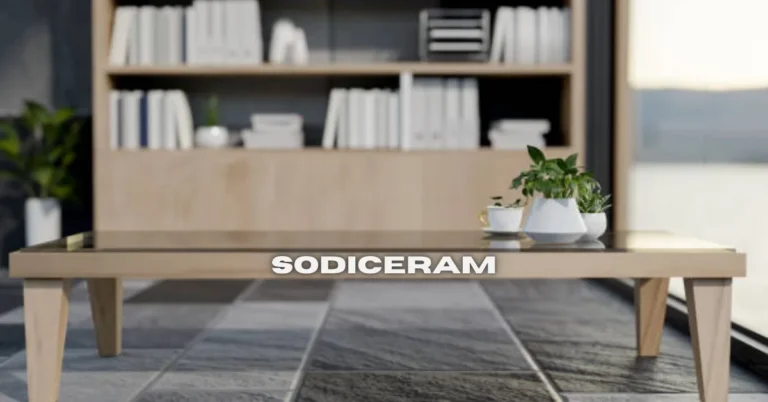‘sIn a world where design trends come and go, the lasting appeal of ceramics endures—timeless, resilient, and quietly transformative. Among the rising stars in this landscape is Sodiceram, a brand that has masterfully blended traditional craftsmanship with contemporary innovation. But what exactly makes Sodiceram more than just another ceramics company? It’s a tale of heritage meeting modern demands, art converging with practicality, and a vision to reshape how we live within and around ceramic spaces.
What is Sodiceram? Defining the Brand and Concept
Sodiceram is not merely a producer of ceramic goods—it’s a philosophy wrapped in clay and kiln-fired precision. The brand represents a commitment to creating durable, aesthetically compelling ceramic products that suit the varied tastes of today’s homeowners, architects, and designers. Rooted deeply in craftsmanship traditions, Sodiceram reimagines ceramic art through the lens of contemporary design, ensuring that each product is both functional and a statement piece.
The Origin and Philosophical Roots of Sodiceram
The genesis of Sodiceram lies in the intersection of age-old ceramic artistry and a response to modern architectural and interior design needs. Historically, ceramics have served as both utilitarian and decorative objects—from ancient earthenware to elaborate tiles. Sodiceram’s founders envisioned a brand that honors this legacy while pushing boundaries to meet the durability and style expectations of the 21st century. The philosophy is simple yet profound: create ceramics that are timeless in design and robust in function, marrying beauty with endurance.
Continue your journey: This related article is worth your time.
Real-World Applications: Beyond Tiles to Transformative Design
Sodiceram’s impact extends far beyond the surface of floors and walls. In residential spaces, its ceramic collections become a foundation for elegance and resilience, adapting to minimalist interiors as smoothly as lavish, ornate environments. Commercially, Sodiceram tiles and ceramics are chosen for their ability to withstand heavy use without sacrificing style—restaurants, hotels, and offices benefit from this balance.
Beyond traditional applications, there’s potential for Sodiceram’s approach to influence smart design and sustainability in architecture. As buildings become more eco-conscious, durable ceramic materials like those from Sodiceram offer a sustainable alternative to synthetic surfaces. Their long life cycle means less frequent replacement, reducing waste and carbon footprint.
How Sodiceram Stands Apart: A Comparison with Other Ceramic Brands
While many ceramic producers focus primarily on either traditional designs or mass-produced modernity, Sodiceram strikes a nuanced balance. Unlike companies that prioritize aesthetics over durability, or vice versa, Sodiceram integrates both without compromise. Its production techniques blend artisan handcrafting with state-of-the-art manufacturing, setting it apart from conventional ceramic protocols that often lean heavily on one approach.
Furthermore, Sodiceram’s dedication to design versatility—ranging from understated, neutral palettes to bold, intricate patterns—positions it uniquely in a market often segmented by style. This duality appeals to both trend-conscious designers and those seeking timeless classics.
Future Implications: Innovation, Ethics, and Opportunities in Ceramics
Looking forward, Sodiceram embodies the potential evolution of ceramics as a material deeply connected to sustainable living and technological innovation. Ethical sourcing of raw materials, eco-friendly production processes, and the integration of smart ceramic technologies could define its trajectory.
Risks lie in market saturation and the challenge of maintaining authenticity amid growth, but opportunities abound. Ceramic materials enhanced with nanotechnology or embedded sensors could transform buildings into responsive environments, blending beauty and intelligence. Sodiceram could lead this charge, turning ceramics from a static backdrop into an interactive layer of the modern home.
Best Practices in Designing with Sodiceram Ceramics
Designing with Sodiceram requires balancing aesthetics and function. Consider the following:
Choose for context: Match ceramic styles and durability with the environment—high traffic areas demand tougher finishes.
Play with contrast: Use bold Sodiceram tiles as statement pieces against minimalist backgrounds to create dynamic spaces.
Layer textures: Mix ceramic textures with wood, metal, or fabric to enrich the sensory experience.
Sustainability matters: Opt for products with verified eco-friendly certifications to align with green building principles.
Future-proof design: Plan for adaptability—Sodiceram’s diverse collections allow easy updates as tastes evolve.
Conclusion: The Human Meaning Behind Sodiceram’s Craft
Sodiceram’s rise is more than a commercial success; it symbolizes a deeper human desire to live surrounded by objects that endure and inspire. Like a well-crafted story, ceramics tell tales of culture, innovation, and identity. In embracing durability and grace, Sodiceram invites us to rethink our relationship with everyday materials, urging a return to mindful consumption and timeless beauty.
Don’t miss out on more great reads—click through our featured posts!
FAQs
What is Sodiceram?
Sodiceram is a ceramics brand combining traditional craftsmanship with modern design to create durable, stylish ceramic products.
How is Sodiceram different from other ceramic brands?
Sodiceram uniquely balances durability and aesthetic versatility, blending artisan techniques with modern manufacturing.
Where can Sodiceram ceramics be used?
They are suitable for both residential and commercial spaces, including floors, walls, and decorative installations.
Is Sodiceram’s environmentally friendly?
Yes, the brand focuses on sustainable sourcing and production methods to reduce environmental impact.

